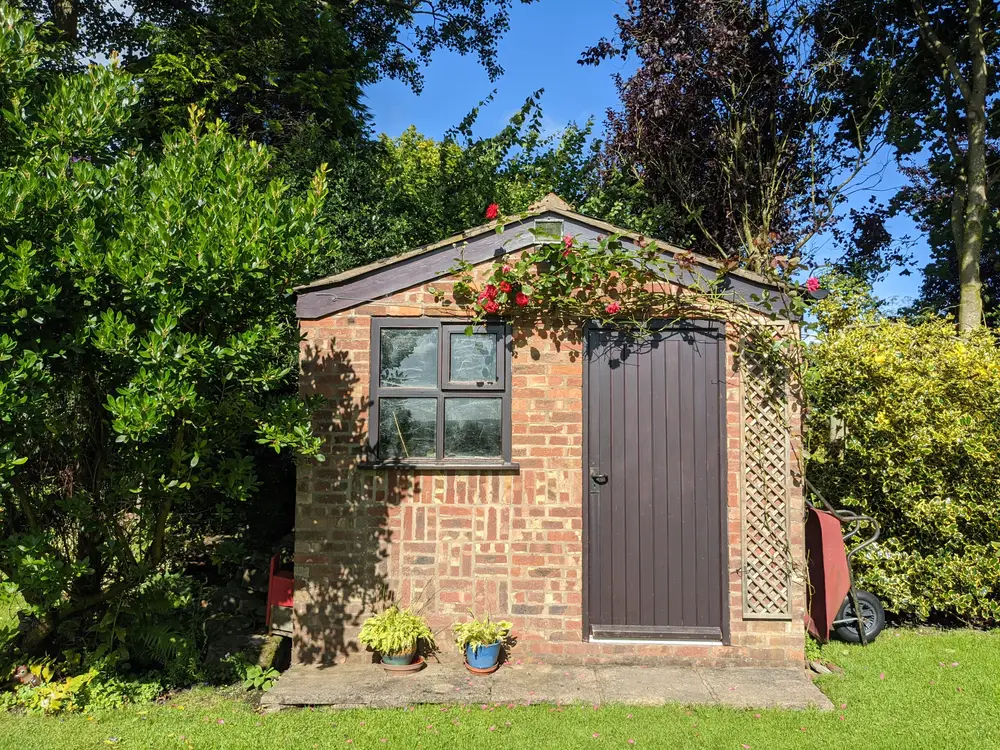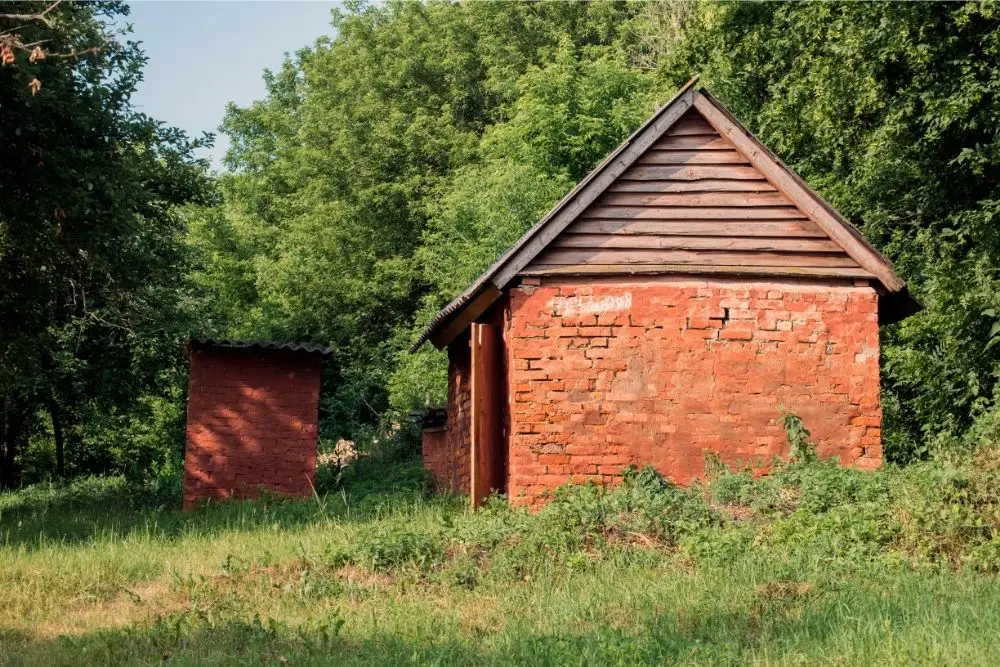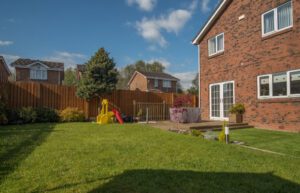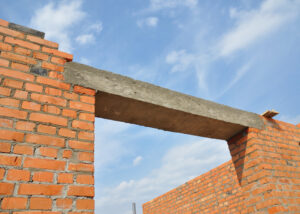Are you considering adding a brick shed to your property in the UK? Wondering if you need to go through the hassle of obtaining planning permission? Let me guide you through the regulations and rules surrounding brick sheds and planning permission in the UK.

Key Takeaways:
- Permitted development rights introduced in 2008 allow homeowners to add outbuildings like brick sheds without planning permission in most cases.
- There are guidelines to follow, such as the shed not covering more than 50% of the total garden space and not being in the front garden.
- Exceptions apply for listed buildings, designated lands, and certain areas in Northern Ireland and Scotland.
- It is always advisable to check with your local council’s planning department for certainty.
- Building regulations will still apply to ensure the shed is constructed to a high standard and meets safety requirements.
Brick Sheds and Permitted Development Rights
When it comes to adding a brick shed to your property in the UK, it’s essential to understand the concept of permitted development rights. These rights were introduced in 2008 to allow homeowners to construct certain types of outbuildings, including brick sheds, without the need for planning permission.
To fall under permitted development, a brick shed must be built for a purpose “incidental to the enjoyment of the dwelling house” and cannot be used as a living area. This means that the shed should be primarily used for activities such as hobbies, storage, or similar purposes.
There are a few key considerations to keep in mind when building a brick shed under permitted development rights. Firstly, the shed should not cover more than 50% of the total garden space. Additionally, it should not be located in the front garden. As for height restrictions, the shed should not exceed 2.5m at the eaves or 3m overall. These requirements ensure that the shed remains in harmony with the surrounding environment and does not obstruct sightlines.
To give you a clearer understanding, here is a table summarizing the main restrictions and requirements for building a brick shed under permitted development rights:
| Restrictions and Requirements | Details |
|---|---|
| Coverage | No more than 50% of the total garden space |
| Location | Not in the front garden |
| Height | 2.5m at the eaves or 3m overall |
By adhering to these guidelines, you can confidently build a brick shed on your property, knowing that you are within the boundaries of permitted development rights. However, it’s always a good idea to consult your local council’s planning department to ensure that your plans comply with any additional regulations specific to your area.
What You Can Build Under Permitted Development
Permitted development rights in the UK allow homeowners to construct brick or breeze block sheds without the need for planning permission. These types of sheds are perfect for hobbies, storage, and other similar purposes. However, it is crucial to adhere to certain rules and guidelines to ensure compliance with permitted development regulations.
Firstly, the size of the shed must not exceed 50% of the total garden space. This ensures that the shed does not dominate the landscape and maintains a suitable balance in the overall design. Additionally, the shed should not be located in the front garden, as permitted development rights typically apply to structures at the rear of the property.
Height restrictions also apply when constructing a brick shed under permitted development. The shed should not exceed 2.5m in height at the eaves or 3m overall. If the shed is within 2m of the property edge, it should not exceed 2.5m in height to ensure it does not obstruct neighboring properties or compromise privacy.
| Permitted Development Guidelines for Brick Sheds | |
|---|---|
| Size | Not more than 50% of the total garden space |
| Location | Not in the front garden |
| Height | Maximum 2.5m at the eaves or 3m overall; if within 2m of the property edge, maximum 2.5m in height |
By following these guidelines, you can confidently construct a brick or breeze block shed under permitted development rights without the need for planning permission. However, it is always advisable to consult with your local council’s planning department to ensure compliance with any specific regulations or restrictions that may apply in your area.
When Permitted Development Doesn’t Apply
If you live in certain circumstances, permitted development rights may not apply to your brick shed. It is important to be aware of these exceptions to avoid potential penalties or delays in your project. Below are some situations in which planning permission would be required:
- If your property is a listed building, you will need to obtain planning permission for any changes or additions, including a brick shed.
- Designated lands, such as national parks or protected areas, also require planning permission for any construction, regardless of permitted development rights.
- Conservation areas have additional restrictions, and planning permission may be necessary for a brick shed, even if it meets the criteria for permitted development.
- Sites of Special Scientific Interest (SSSI) have strict regulations to protect the environment, and planning permission would be required for any construction, including a brick shed.
It is important to note that the rules and regulations for permitted development rights may vary in different parts of the UK. If you are unsure about whether your property falls under any of these exceptions, it is best to consult with your local council’s planning department for guidance.
Comparison Table: Permitted Development vs. Planning Permission
| Permitted Development | Planning Permission |
|---|---|
| No need to apply for planning permission | Requires formal application and approval |
| Subject to specific rules and restrictions | May have additional requirements based on local regulations |
| Can be carried out without delays | Approval process can take 8-10 weeks |
| Applies to most residential properties | Exceptions for listed buildings, designated lands, and certain areas |
As you can see from the comparison table, while permitted development rights offer flexibility and convenience for most homeowners, there are circumstances where planning permission is necessary. Understanding these exceptions and seeking the appropriate approvals will ensure that your brick shed project complies with the regulations and avoids any legal issues in the future.

Applying for Planning Permission
If you are unsure whether you need planning permission for your brick shed, it is best to check with your local council’s planning department. They will be able to provide you with the necessary information and guidance to ensure compliance with the regulations in your area. Applying for planning permission can seem like a daunting process, but it is essential to ensure that your brick shed is legal and meets all necessary requirements.
The application process for planning permission is now largely online through the government’s planning portal. This makes it easier and more convenient to submit your application and track its progress. However, it is important to note that the process can take 8-10 weeks to process, so it is advisable to submit your application well in advance of when you plan to start construction.
When submitting your planning permission application, you will need to provide detailed information about your brick shed, including its purpose, size, and design. It is crucial to be clear and accurate in your application to avoid any potential delays or complications. The local council will review your application and assess whether it complies with the necessary regulations and guidelines.
Table: Planning Permission Application Process
| Step | Description |
|---|---|
| 1 | Check with your local council |
| 2 | Visit the government’s planning portal |
| 3 | Submit your application |
| 4 | Provide detailed information about your brick shed |
| 5 | Wait for the council’s decision |
Building Regulations for Brick Sheds
When constructing a brick shed in the UK, it is essential to understand that building regulations will always apply, regardless of whether planning permission is required. These regulations focus on ensuring that the construction meets specific standards and requirements to guarantee the shed’s safety and quality.
One important aspect to consider is insulation. Building regulations may require the shed to have suitable insulation to maintain a comfortable temperature and reduce energy consumption. Adequate insulation will help keep the shed warm during colder months and prevent excessive heat during the summer.
| Factor | Building Regulation |
|---|---|
| Insulation | Proper insulation may be required to maintain temperature control and energy efficiency. |
| Electrical Wiring | If the shed is equipped with electricity, the electrical wiring should meet safety standards and be installed by a qualified electrician. |
| Structural Stability | The shed must be structurally sound, able to withstand wind and other environmental factors. The foundation should be sturdy and well-built. |
Additionally, if your brick shed includes electrical wiring, specific regulations must be followed. The electrical work should be carried out by a qualified electrician who will ensure that the wiring is safe and meets the necessary standards.
Complying with building regulations is crucial to ensure the longevity and safety of your brick shed. It is recommended to consult with a professional builder or architect who can guide you through the regulations and help ensure that your construction meets all the necessary requirements.https://www.youtube.com/embed/Jujp097Qy5I
Summary
- Building regulations always apply when constructing a brick shed in the UK.
- Insulation may be required to maintain temperature control and energy efficiency.
- If the shed has electrical wiring, it must be installed by a qualified electrician.
- The shed must be structurally stable and built to withstand environmental factors.
Conclusion
After exploring the regulations surrounding brick sheds in the UK, it is clear that careful consideration is needed when planning your project. While many homeowners can take advantage of permitted development rights and avoid the need for planning permission, it is crucial to adhere to certain rules and restrictions.
Remember, your brick shed should not cover more than 50% of your garden space and should not be located in the front garden. Additionally, ensure that the height restrictions of 2.5m at the eaves or 3m overall are followed.
Even if you do not require planning permission, building regulations will always apply. These regulations focus on construction standards and ensure that your shed is safe and meets certain requirements. It is important to prioritize factors like insulation and energy efficiency to create a high-quality and secure structure.
In conclusion, building a brick shed can be a valuable addition to your property, providing extra storage or hobby space. By understanding the rules surrounding planning permission and building regulations, you can confidently embark on your brick shed project and enjoy the benefits it brings to your home.
FAQ
Do I need planning permission for a brick shed in the UK?
Permitted development rights introduced in 2008 allow homeowners to add outbuildings like brick sheds without the need for planning permission. However, there are rules and restrictions to follow. It is always best to check with your local council’s planning department for certainty.
What are permitted development rights?
Permitted development rights were introduced in 2008 to allow homeowners to add outbuildings like brick sheds without the need for planning permission. The main requirement is that the shed must be for a purpose “incidental to the enjoyment of the dwelling house” and not used as a living area.
What can I build under permitted development?
Under permitted development, you can build a brick or breeze block shed for hobbies, storage, or similar purposes without the need for planning permission. However, it must comply with certain rules, such as not covering more than 50% of the garden space and not being in the front garden.
When doesn’t permitted development apply?
There are exceptions to permitted development rights. If you live in a listed building, designated lands, or areas such as conservation areas or Sites of Special Scientific Interest, permitted development rights do not apply, and you will need planning permission for your brick shed.
How do I apply for planning permission?
If you are unsure whether you need planning permission for your brick shed, it is best to check with your local council’s planning department. Provide them with all the necessary information about the shed’s purpose, size, and design, and they will be able to advise you on whether you need planning permission.
What are the building regulations for brick sheds?
Regardless of whether you need planning permission, building regulations will always apply to your brick shed. Building regulations focus on the construction standards and ensure that the shed is safe and meets certain requirements. It is important to comply with building regulations to ensure a high-quality and safe construction.
- Drill Battery Maintenance: Essential Tips for Cordless Drill Battery Care - February 5, 2024
- Troubleshooting Drill Issues - February 5, 2024
- Quick Drilling Techniques - February 2, 2024





